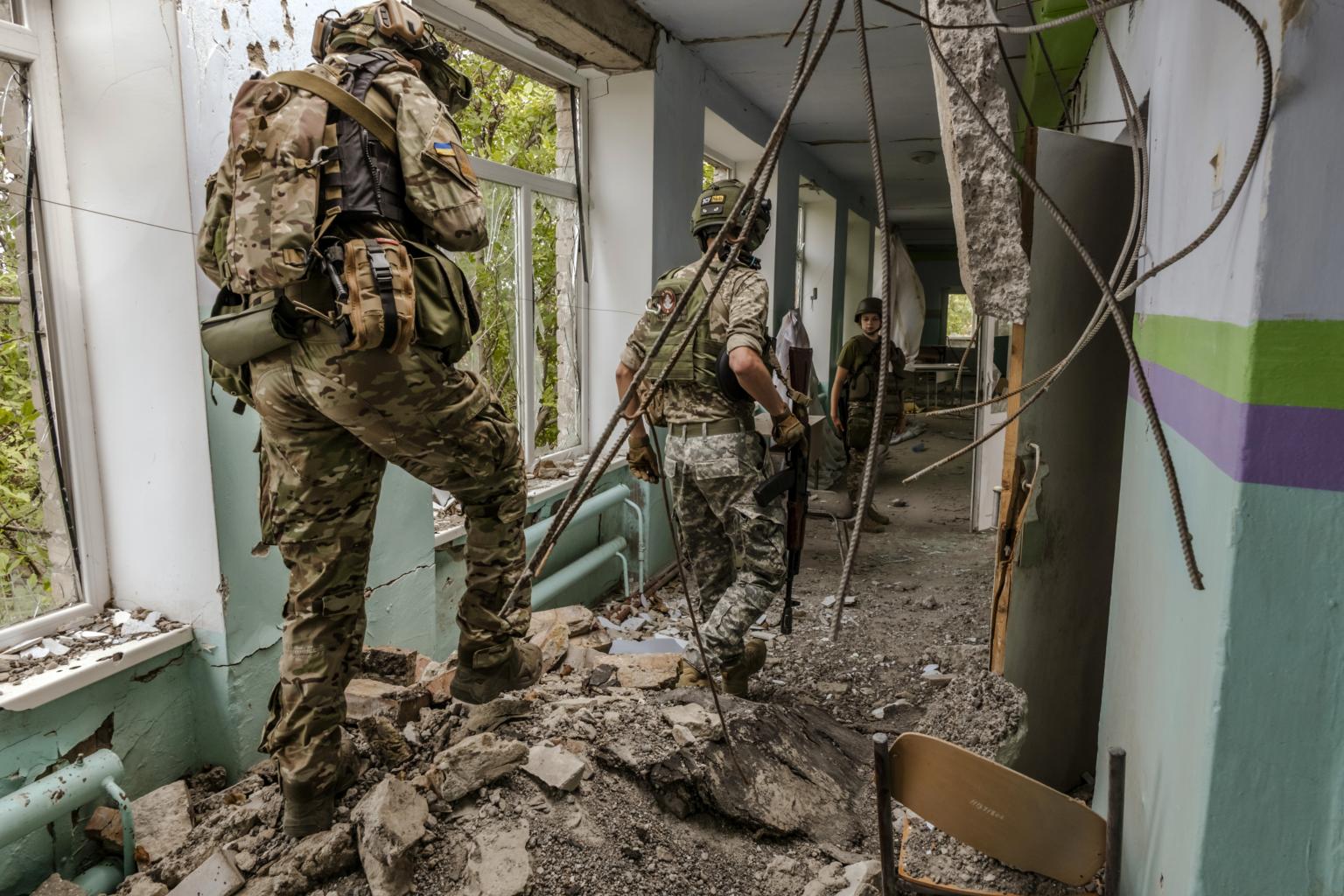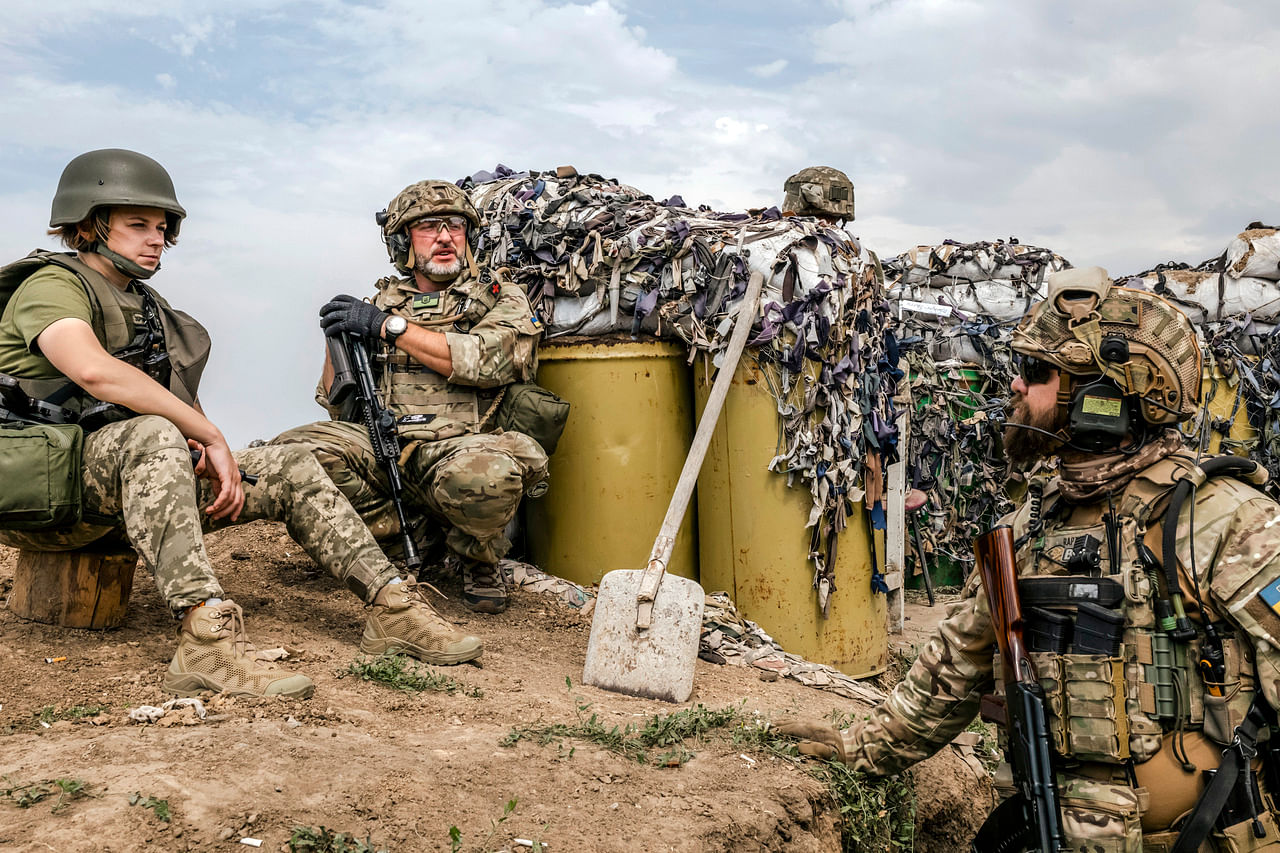Ukraine chips away at Russian-held Kherson, but task is daunting
Sign up now: Get ST's newsletters delivered to your inbox

Ukrainian soldiers walk through the ruins of a school in the Mykolaiv region on Aug 11, 2022.
PHOTO: NYTIMES
Follow topic:
MYKOLAIV, UKRAINE (NYTIMES) - In their summer campaign to drive Russian troops from the southern region of Kherson, Ukraine's forces have decimated Russian command centres and ammunition depots, severed supply lines with precision strikes on key bridges, and sown terror among collaborationist officials with a spate of car bombings, shootings and, Ukrainian officials said, at least one poisoning.
But in the sunbaked fields along the Kherson region's western border, the Ukrainian fighters who would be called on to deliver the knockout blow in any successful effort to retake territory remain pinned down in their trenches. The cuts to supply lines have not yet eroded Moscow's overwhelming advantage in artillery, ammunition and heavy weaponry, making it difficult, if not impossible, for Ukrainian forces to press forward without suffering enormous casualties.
"Without question we need a counteroffensive; I sincerely believe it will come," said a 33-year-old lieutenant with the call sign Ada, who commands an outpost of trenchworks in the Mykolaiv region, a few miles from the Russian lines in Kherson.
But he said: "We need the advantage in numbers, we need the advantage in heavy weapons. Unfortunately, this is a bit of a problem for us."
Ukrainians have acutely felt the loss of the Kherson region, with its vast black-earth farmlands famous for producing the country's tastiest tomatoes and watermelons. Just about the entire region was seized in the first weeks of the war after Russian troops struck from their bases in the Russian-occupied Crimean Peninsula. Since then, Ukraine's leaders have plotted to take it back.
But doing so presents major challenges.
Russia maintains overwhelming superiority in troop numbers and ammunition, and in recent weeks the Kremlin has moved to reinforce its military in the region, shifting resources there from the fighting in the eastern Donbas. Even if Ukraine's military is able to squeeze Russian forces out of the rural farmlands, they will most likely have to fight a vicious urban battle for the city of Kherson, which could lead to huge losses in lives and property.
Ukraine is also operating under a condensed timeline. The Kremlin plans to hold a referendum on Kherson's absorption by Russia in mid-September, and disrupting it would require Ukraine's president, Volodymyr Zelensky, and his generals, to take some kind of significant offensive action soon, experts said.
"The real limitations the Ukrainians face is that moving forward in the combat environment today is really difficult," said Phillips P. O'Brien, a professor of strategic studies at the University of St. Andrews in Scotland. "Unless you have total command of the skies and the ability to clear out the area in front of your troops, those moving forward are in real danger of getting eaten away."
But Russia's position in Kherson is also precarious, O'Brien and others said.
Though Ukrainian troops have not advanced for weeks in Kherson, their artillery campaign appears to have borne fruit, slowing the flow of Russian arms, equipment and troops into the region, Ukrainian officials say.
Using high-precision weapons such as the American-supplied High Mobility Artillery Rocket System, or HIMARS, Ukrainian forces have pounded the three bridges over the vast Dnieper River that connect thousands of Russian troops to their supply lines in occupied Ukrainian territory east of the river.

The strikes have rendered these bridges "inoperable," said Ms Nataliya Gumenyuk, the spokesperson for the Ukrainian military's southern command. Over the weekend, Ukrainian forces launched yet another strike on the Antonivsky Bridge, the main supply artery into the city of Kherson.
The question now is whether the pressure on supply lines will be sufficient to cripple the fighting capacity of Russian troops and perhaps force the Kremlin to order at least part of the force to withdraw from Kherson and fall back across the river.
Several Ukrainian officials in the region said this week that some Russian field commanders had already begun to move their headquarters east of the river, although two senior Ukrainian military officials said there was no evidence of this.
Along with additional forces, Russia may have already moved large amounts of equipment and ammunition into the region, allowing it to fight on for some time, even with supply lines severely disabled, said Ben Barry, a senior fellow at the International Institute for Strategic Studies, a research group based in London.
And even with the bridges destroyed, Russia would still have options to resupply.
"The prospect of being isolated from the rest of their forces won't do anything for the morale of Russian troops defending in the Kherson Oblast," Barry said. "But on the other hand, Russia has a lot of military bridging, it's got quite a lot of ferries, it's got riverboats."
Over the long run, pressure from Ukraine could turn Russia's precarious position into an untenable one, said Michael Kofman, director of Russian studies at CNA, a research institute in Arlington, Virginia. But this could take months, not weeks, he said, and could sap the Ukrainian military of the resources it would need to pursue other campaigns.
"The position that the Russian military has taken in Kherson is the least defensible of the territories they have occupied," Kofman said. "Once those bridges are gone and once the railway bridge connector into Kherson is gone, then they're going to have a very hard time getting ammunition there. They'll have to retreat to positions that, at best, are outside the city."

Looking east towards the Russian lines last week from behind a sandbag-reinforced trench position just over the border with the Kherson region, the task of pushing Russian forces back appeared daunting.
Each day a withering barrage of Russian strikes inevitably kills a handful troops there and wounds many more, Ada, the local commander, said. A near miss by a Grad rocket a day earlier charred the grass around one dugout position and, in the field nearby, the tail section of another rocket was visible sticking out of the ground. Periodically, a low-decibel thud reverberated across the plains.
It is the same all across the roughly 50-mile Kherson front, which cuts northeast to southwest through farmland and once-tidy villages now mostly blown apart and abandoned.
Ukraine's commanders and military analysts said that any push forward would require vastly more troops and equipment than Ukraine has in the Kherson theatre at the moment, as both armies fight on several fronts.

In the Luhansk region in the east, Ukrainian officials claimed to have hit a base that housed mercenaries from the Wagner Group, a private military organisation with close ties to President Vladimir Putin of Russia. There was no immediate comment from authorities in Russia. In the southeast, shelling near the Zaporizhzhia nuclear power plant hit a fire station that responds to blazes inside the sprawling facility, officials said Monday, adding to concerns over nuclear safety in the area.
Major Gen Dmytro Marchenko, the commander of Ukraine's forces in the region, recently acknowledged bubbling frustrations with the slow pace of Ukraine's efforts to retake Kherson, but he said he could give no timetable for the start of major offensive actions.
"I want to tell the people of Kherson to be a little patient - that it will not be as long as everyone expects," Marchenko said in an interview last week with RBK-Ukraine. "We have not forgotten about them. No one will abandon our people, and we will come to help them. But they need to wait a little longer."

